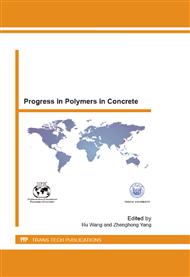p.378
p.384
p.391
p.397
p.403
p.409
p.416
p.426
p.430
Strategies for Optimizing Mineral Corrosion Protection Mortars Used in a Sea-Water Environment
Abstract:
Corrosion protection is absolutely essential for offshore steel constructions. As an alternative to the conventional corrosion protection systems, a thin layer of high-performance mortar (HPM) could be applied around the steel tower to protect it against the harsh marine conditions. In order to produce such a mineral system, a dense mortar with a high durability against chlorides, frost and abrasion should be designed. Furthermore, the application techniques of the corrosion protection systems require a mortar with high fluidity and high segregation resistance. This is achieved by using a high content of cement and through the addition of pozzolanic additives, such as fly ash and silica fume. However, the risk of autogenous shrinkage also rises with the increasing content of cement and silica fume, leading to microcracks in the mineral corrosion protection layer. The occurrence of cracks ultimately leads to an increased chloride and water ingress. The main objective of this research work is to improve the shrinkage behaviour of the HPM by using several admixtures. In addition to superabsorbent polymers (SAP), the effects of a shrinkage-reducing admixture (SRA) were investigated. Some conclusions were drawn about the effects of these admixtures based on the linear shrinkage strain, which was measured using a shrinkage cone. Furthermore, it is supposed that the SAPs have a positive influence on the mortar’s durability by interrupting the capillary pore structure in the hardened mortar. After hydration, the initial water-filled SAPs leave small well-distributed pores inside the hardened cement, thereby increasing the resistance against water and chloride ingress. Moreover, the remaining air voids provide additional room to accommodate the volume increment during frost periods. Both, the reductions of the autogenous shrinkage and the increased resistance against ingress of chlorides and water will be discussed in this paper.
Info:
Periodical:
Pages:
403-408
Citation:
Online since:
April 2013
Authors:
Price:
Сopyright:
© 2013 Trans Tech Publications Ltd. All Rights Reserved
Share:
Citation:


